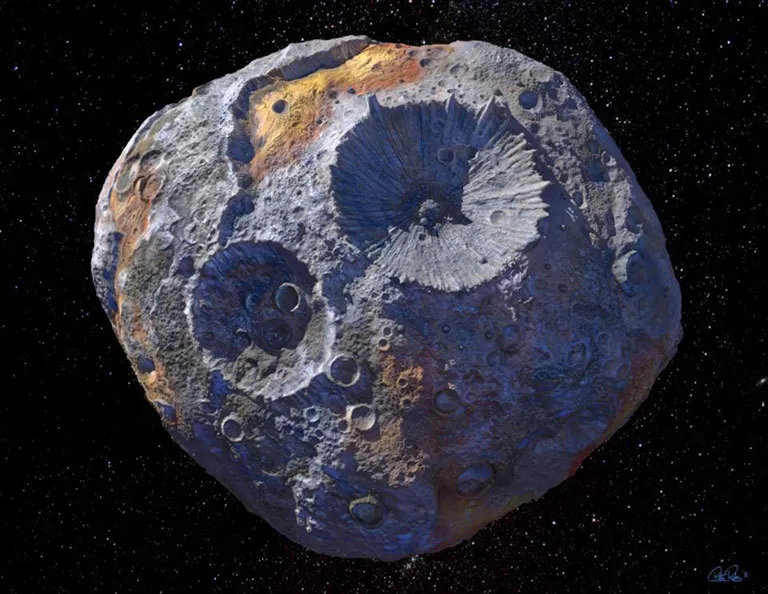“There is something rotten in Denmark,” wrote Shakespeare. “There is gold in asteroids!” I write (I like to win easy). Literally: Asteroids have more than enough gold, plus other metals, to make up a generation's worth of crazy fortunes. And that's not the only profitable thing about asteroids!
Good. How could we get these metals from these distant asteroids?
Perhaps the best way is to bring space rocks to Earth.
Most of the metals we use in our daily lives are buried deep within the Earth. And when I say "deep", I mean it: when our planet was still molten, almost all the heavy metals sank into the core, rather difficult to reach. The accessible veins of gold, zinc, platinum and other precious metals came from successive asteroid impacts on the Earth's surface.
Those asteroids are the fragmented remains of “quasi-planets,” but they contain all the same mixes as planets. And you don't need to dig into their cores to get them: the asteroid 16 Psyche, for example, contains about 10 billion billion pounds (22 billion billion pounds) of nickel and iron. We would need them for… EVERYTHING: from reinforced concrete to cell phones.
Asteroids such as Psyche could, alone, meet our industrial needs for several million years.

Asteroids: They are fast and (usually) distant
The main problem with asteroids, however, is that they are distant and elusive. They travel very fast over great distances (in some ways it's better). Realize that to enter orbit, a rocket must change its speed zero to 8 kilometers per second (5 miles per second). To meet an average asteroid, the rocket must nearly double its speed. We need to accelerate by an additional 5,5 kilometers per second (3,4 miles per second).
This requires almost as much fuel as the launch itself. The rocket would have to carry all this dead weight, increasing costs exorbitantly. Not to mention the prohibitive ones of a remote extraction operation.
Once hooked, asteroid seekers then face a difficult choice: to try to refine the mineral right there on the spot. This would involve the creation of an entire refining plant. Alternatively, ship the ore to Earth, with all the waste that would entail.
Bring the loaf home
What if instead of hooking distant asteroids, extracting minerals from them and bringing them back to Earth... we didn't bring the asteroids themselves directly (slowly) to Earth? The mission Asteroid Redirect Mission (ARM) NASA set out to do just that. The goal was to grab a 4-meter (13-foot) boulder from a nearby asteroid and return it to cislunar space (between the orbits of the Earth and the moon), where we could study it at our leisure.
To move the boulder, ARM would have used solar electric propulsion, with solar panels that absorb sunlight and convert it into electricity. That electricity, in turn, would power an ion engine. It wouldn't be very fast, but it would be efficient and it would get the job done in the end.
Unfortunately, in 2017, NASA canceled the ARM mission. Some of the critical technologies for capturing asteroids have ended up in other projects, such as the mission OSIRIS-REx on asteroid Bennu, and NASA continues to investigate and use ion engines. If properly scaled, a future version of ARM could potentially send large chunks of asteroids, if not entire small asteroids, into near outer space.
Hunting for big space nuggets…. er, asteroids!
In fact, a recent study found a dozen potential asteroids, ranging from 2 to 20 meters in diameter (6,6 to 66 feet). They could be brought into near-Earth orbit with a change in speed of less than 500 meters per second (1.640 feet per second). And the solar electric propulsion schemes devised for ARM would be perfectly capable of doing so, although it would take some time.
By bringing these asteroids to areas relatively closer to Earth, many of the difficulties of mineral extraction would be reduced. Just compare the ease of reaching low Earth orbit, or even the moon, to that of reaching Mars. The Red Planet's extreme distance from Earth presents enormous logistical, engineering and technical challenges that we are still trying to solve, while we have maintained a continuous human presence in low Earth orbit for over two decades.
A cislunar asteroid would be much easier to study and much easier to test on different mining strategies. Furthermore, its resources would be much easier to bring back to Earth.
Save the world and earn
You will surely have thought about it. Developing and perfecting this technology would not only serve to extract immense fortunes from asteroids, but also to divert their course. If we can successfully change the speed and orbit of harmless asteroids, we can potentially do so for dangerous asteroids that threaten Earth. Solar electric propulsion, for example, may be humanity's best chance of avoiding calamity.


